Abstract
Reverse transcription coupled with the polymerase chain reaction (RT-PCR) was used for the detection and differentiation of pestiviruses. For this purpose, one primer pair was selected from a highly conserved region of the genome of pestiviruses. Using these primers (PEST 1-PEST 2), DNA fragments of between 72 and 74 bp could be amplified from all pestivirus isolates tested. In order to differentiate hog cholera virus (HCV) from bovine viral diarrhea virus (BVDV) and border disease virus (BDV), we selected a primer pair from a conserved region in the genome of HCV strains that differed from that sequenced in the genome of BVDV strains. By using these primers (HCV 1-HCV 2), a DNA fragment of 478 bp could be specifically amplified from HCV isolates. By these means, viral RNA was detected in extracts of lymph node, spleen, tonsil, and lung. Such extracts were used directly for RT-PCR without prior RNA isolation. We also performed multiplex PCR by using both the PEST 1-PEST 2 and HCV 1-HCV 2 primer pairs in a single reaction. This allowed the differentiation of HCV from BVDV and BDV in one step. To assess the sensitivity of the method, RT-PCR was compared with virus propagation in tissue culture and subsequent detection by immunofluorescence staining. The results show that RT-PCR is useful for the rapid detection and differentiation of pestiviruses.
Full text
PDF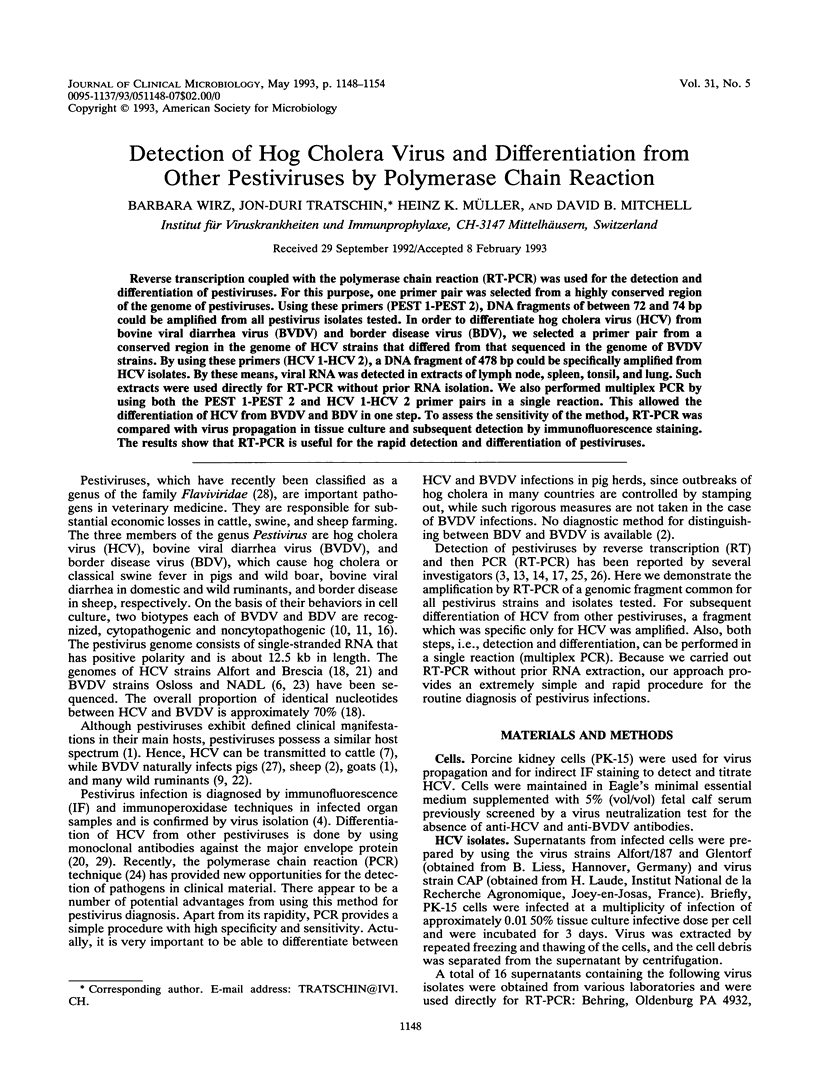
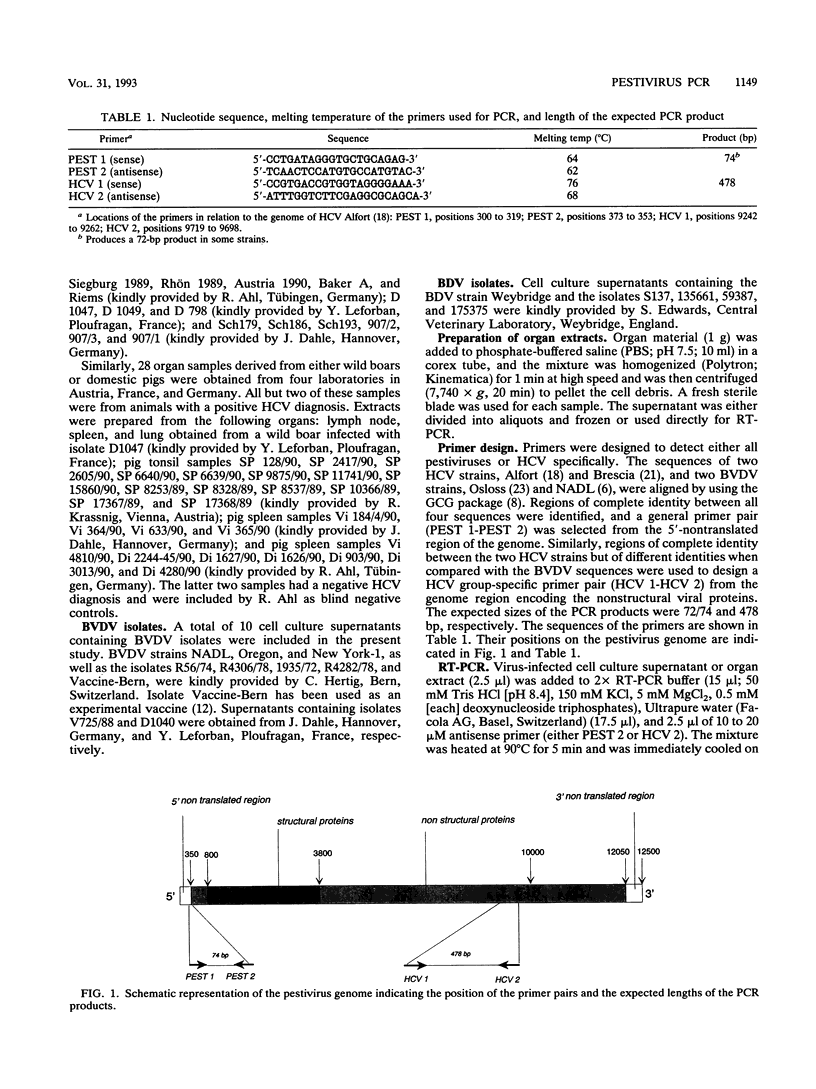
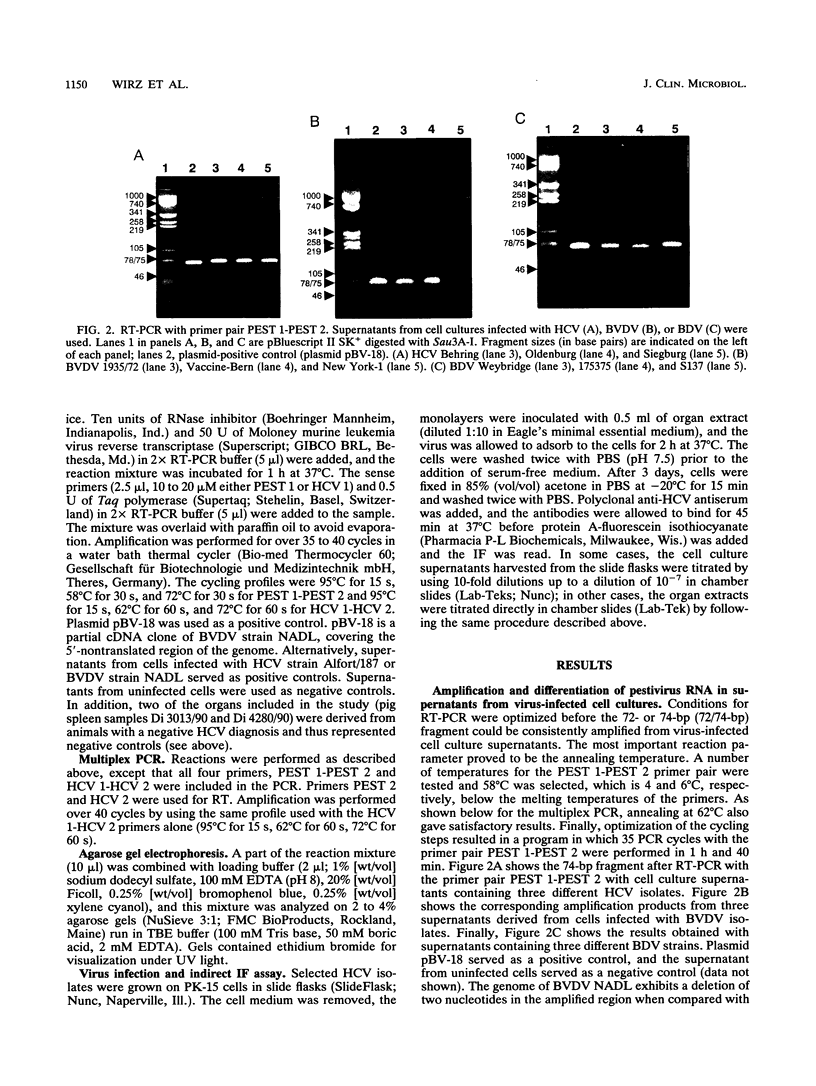
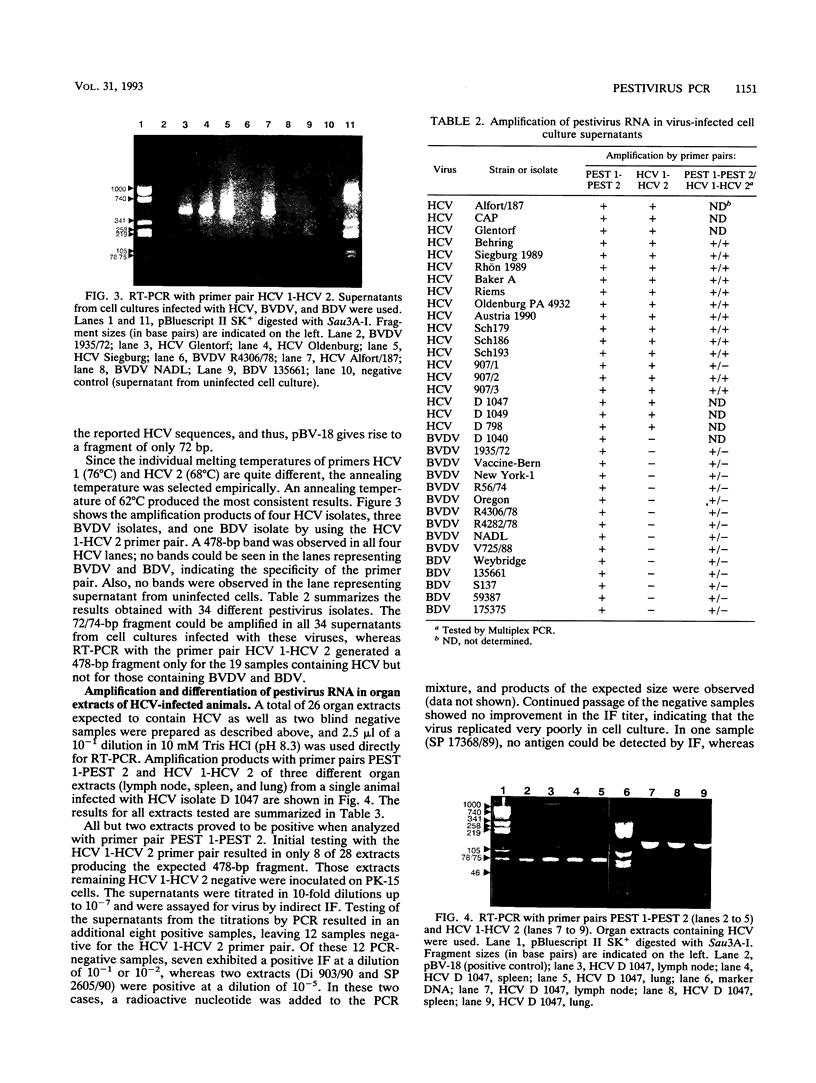

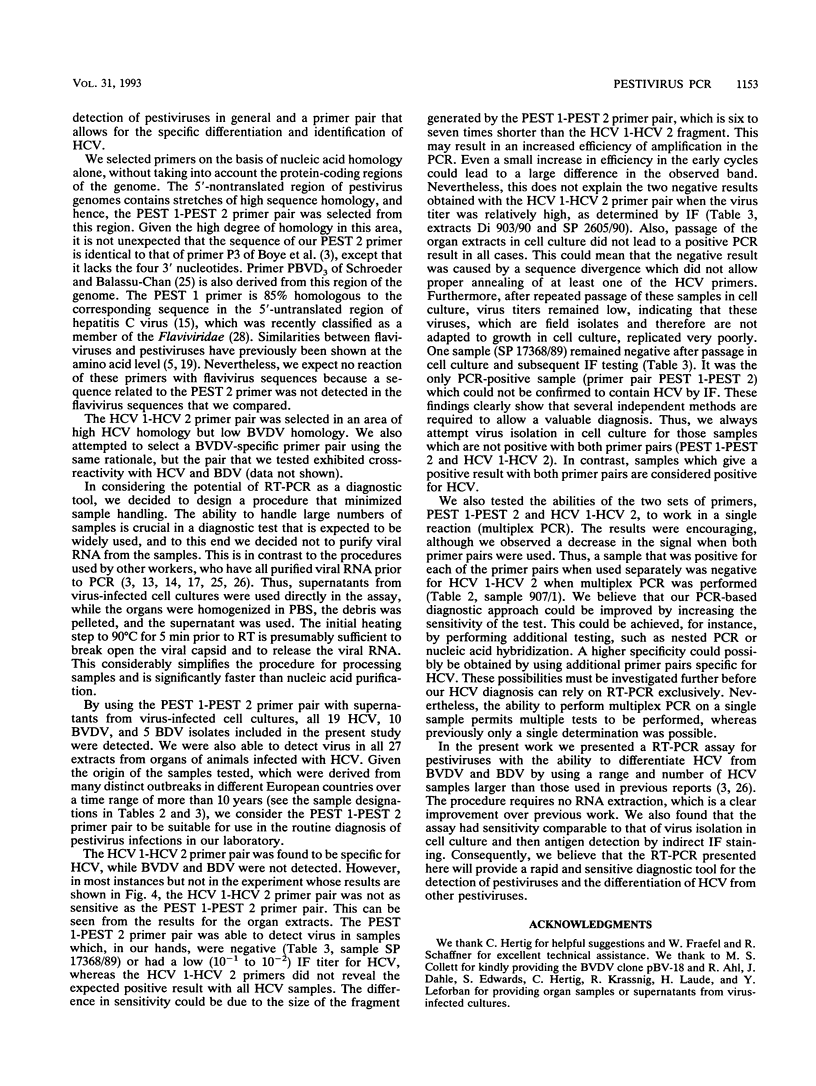
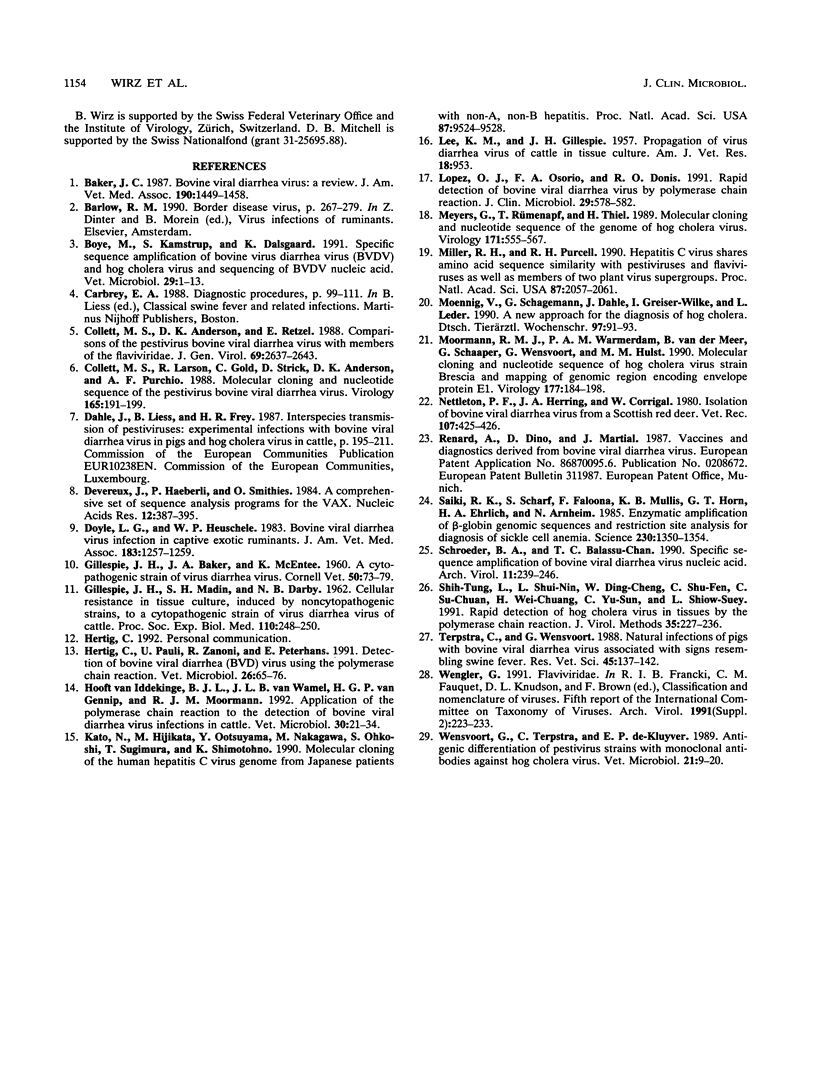
Images in this article
Selected References
These references are in PubMed. This may not be the complete list of references from this article.
- Baker J. C. Bovine viral diarrhea virus: a review. J Am Vet Med Assoc. 1987 Jun 1;190(11):1449–1458. [PubMed] [Google Scholar]
- Boye M., Kamstrup S., Dalsgaard K. Specific sequence amplification of bovine virus diarrhea virus (BVDV) and hog cholera virus and sequencing of BVDV nucleic acid. Vet Microbiol. 1991 Sep;29(1):1–13. doi: 10.1016/0378-1135(91)90106-p. [DOI] [PubMed] [Google Scholar]
- Colett M. S., Larson R., Gold C., Strick D., Anderson D. K., Purchio A. F. Molecular cloning and nucleotide sequence of the pestivirus bovine viral diarrhea virus. Virology. 1988 Jul;165(1):191–199. doi: 10.1016/0042-6822(88)90672-1. [DOI] [PubMed] [Google Scholar]
- Collett M. S., Anderson D. K., Retzel E. Comparisons of the pestivirus bovine viral diarrhoea virus with members of the flaviviridae. J Gen Virol. 1988 Oct;69(Pt 10):2637–2643. doi: 10.1099/0022-1317-69-10-2637. [DOI] [PubMed] [Google Scholar]
- Devereux J., Haeberli P., Smithies O. A comprehensive set of sequence analysis programs for the VAX. Nucleic Acids Res. 1984 Jan 11;12(1 Pt 1):387–395. doi: 10.1093/nar/12.1part1.387. [DOI] [PMC free article] [PubMed] [Google Scholar]
- Doyle L. G., Heuschele W. P. Bovine viral diarrhea virus infection in captive exotic ruminants. J Am Vet Med Assoc. 1983 Dec 1;183(11):1257–1259. [PubMed] [Google Scholar]
- GILLESPIE J. H., BAKER J. A., McENTEE K. A cytopathogenic strain of virus diarrhea virus. Cornell Vet. 1960 Jan;50:73–79. [PubMed] [Google Scholar]
- GILLESPIE J. H., MADIN S. H., DARBY N. B., Jr Cellular resistance in tissue culture, induced by noncytopathogenic strains, to a cytopathogenic strain of virus diarrhea virus of cattle. Proc Soc Exp Biol Med. 1962 Jun;110:248–250. doi: 10.3181/00379727-110-27481. [DOI] [PubMed] [Google Scholar]
- Hertig C., Pauli U., Zanoni R., Peterhans E. Detection of bovine viral diarrhea (BVD) virus using the polymerase chain reaction. Vet Microbiol. 1991 Jan;26(1-2):65–76. doi: 10.1016/0378-1135(91)90042-e. [DOI] [PubMed] [Google Scholar]
- Hooft van Iddekinge B. J., van Wamel J. L., van Gennip H. G., Moormann R. J. Application of the polymerase chain reaction to the detection of bovine viral diarrhea virus infections in cattle. Vet Microbiol. 1992 Jan;30(1):21–34. doi: 10.1016/0378-1135(92)90091-7. [DOI] [PubMed] [Google Scholar]
- Kato N., Hijikata M., Ootsuyama Y., Nakagawa M., Ohkoshi S., Sugimura T., Shimotohno K. Molecular cloning of the human hepatitis C virus genome from Japanese patients with non-A, non-B hepatitis. Proc Natl Acad Sci U S A. 1990 Dec;87(24):9524–9528. doi: 10.1073/pnas.87.24.9524. [DOI] [PMC free article] [PubMed] [Google Scholar]
- LEE K. M., GILLESPIE J. H. Propagation of virus diarrhea virus of cattle in tissue culture. Am J Vet Res. 1957 Oct;18(69):952–953. [PubMed] [Google Scholar]
- Liu S. T., Li S. N., Wang D. C., Chang S. F., Chiang S. C., Ho W. C., Chang Y. S., Lai S. S. Rapid detection of hog cholera virus in tissues by the polymerase chain reaction. J Virol Methods. 1991 Nov-Dec;35(2):227–236. doi: 10.1016/0166-0934(91)90138-p. [DOI] [PubMed] [Google Scholar]
- Lopez O. J., Osorio F. A., Donis R. O. Rapid detection of bovine viral diarrhea virus by polymerase chain reaction. J Clin Microbiol. 1991 Mar;29(3):578–582. doi: 10.1128/jcm.29.3.578-582.1991. [DOI] [PMC free article] [PubMed] [Google Scholar]
- Meyers G., Rümenapf T., Thiel H. J. Molecular cloning and nucleotide sequence of the genome of hog cholera virus. Virology. 1989 Aug;171(2):555–567. doi: 10.1016/0042-6822(89)90625-9. [DOI] [PubMed] [Google Scholar]
- Miller R. H., Purcell R. H. Hepatitis C virus shares amino acid sequence similarity with pestiviruses and flaviviruses as well as members of two plant virus supergroups. Proc Natl Acad Sci U S A. 1990 Mar;87(6):2057–2061. doi: 10.1073/pnas.87.6.2057. [DOI] [PMC free article] [PubMed] [Google Scholar]
- Moennig V., Schagemann G., Dahle J., Greiser-Wilke I., Leder L. A new approach for the diagnosis of hog cholera. Dtsch Tierarztl Wochenschr. 1990 Feb;97(2):91–93. [PubMed] [Google Scholar]
- Moormann R. J., Warmerdam P. A., van der Meer B., Schaaper W. M., Wensvoort G., Hulst M. M. Molecular cloning and nucleotide sequence of hog cholera virus strain Brescia and mapping of the genomic region encoding envelope protein E1. Virology. 1990 Jul;177(1):184–198. doi: 10.1016/0042-6822(90)90472-4. [DOI] [PubMed] [Google Scholar]
- Nettleton P. F., Herring J. A., Corrigall W. Isolation of bovine virus diarrhoea virus from a Scottish red deer. Vet Rec. 1980 Nov 1;107(18):425–426. doi: 10.1136/vr.107.18.425. [DOI] [PubMed] [Google Scholar]
- Saiki R. K., Scharf S., Faloona F., Mullis K. B., Horn G. T., Erlich H. A., Arnheim N. Enzymatic amplification of beta-globin genomic sequences and restriction site analysis for diagnosis of sickle cell anemia. Science. 1985 Dec 20;230(4732):1350–1354. doi: 10.1126/science.2999980. [DOI] [PubMed] [Google Scholar]
- Schroeder B. A., Balassu-Chan T. C. Specific sequence amplification of bovine viral diarrhoea virus nucleic acid. Arch Virol. 1990;111(3-4):239–246. doi: 10.1007/BF01311057. [DOI] [PubMed] [Google Scholar]
- Terpstra C., Wensvoort G. Natural infections of pigs with bovine viral diarrhoea virus associated with signs resembling swine fever. Res Vet Sci. 1988 Sep;45(2):137–142. [PubMed] [Google Scholar]
- Wensvoort G., Terpstra C., de Kluijver E. P., Kragten C., Warnaar J. C. Antigenic differentiation of pestivirus strains with monoclonal antibodies against hog cholera virus. Vet Microbiol. 1989 Nov;21(1):9–20. doi: 10.1016/0378-1135(89)90014-x. [DOI] [PubMed] [Google Scholar]







